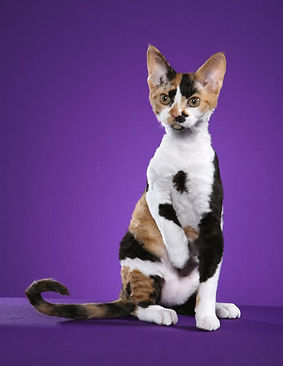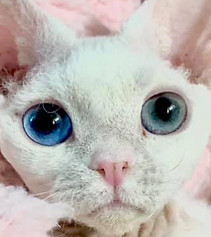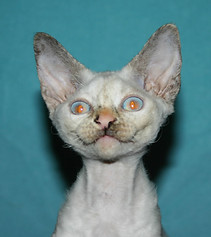Devon Rex
About the Breed













General Description
Devon Rex are the pixies of the cat fancy with their impish looks and mischievous personalities. The Devon Rex have large low set ears and big impish eyes set in a head with a short muzzle and high cheekbones. It is a small to medium sized cat with a muscular body covered with a short, velvety soft coat that ripples with waves. They are often described as resembling the Gremlins from the film Star Wars while the waif-like tousled curls of their coats are reminiscent of Little Orphan Annie's tousled mop.
CLICK HERE FOR THE BREED STANDARD
Scroll to the bottom of the page to see coat colors.
History
Buckfastleigh, Devon, England is the ancestral home of the Devon Rex where a feral tom cat with a curly coat lived in an abandoned tin mine. In 1960, a tortie & white stray adopted by Miss Beryl Cox had a litter of kittens sired by the feral tom. One of the kittens was a brownish-black male with a coat just like his sire's. Miss Cox kept the kitten and named him Kirlee. Aware of Kallibunker (the first Cornish Rex) and the work to preserve that new gene, she wrote to Brian Sterling-Webb thinking her Kirlee could contribute to that program. However, it turned out that the gene creating Kirlee's curly coat was different to the one producing Kallibunker's marcelled waves. There were a number of differences in the coat between Kirlee and the CR. While Kalli had whiskers that were bent and curled, the gene from Devon resulted in missing or stubby whiskers. Kirlee had tight curls but not as uniform as those of Kallibunker giving them a windblown appearance. And Kirlee had huge, low-set ears giving his head a pixie-like look that was accentuated by the large, inquisitive eyes and short nose.
Personality
Devon Rex cats are intelligent, mischievous, and highly active. They are playful and curious, wanting to be involved in everything—and they are incredible jumpers, exploring every nook and cranny! Don’t be surprised to find them perched on top of doors or discovering previously unexplored spots.
Despite their adventurous nature, Devons are very people-oriented and love sharing their explorations with you. Expect them to join you wherever you are—perching on your shoulder while you cook (food is a favorite!), curling up in your lap while you read, or snuggling under the covers at night. Some Devons can be quite talkative. While not as loud as breeds like the Siamese, they may meow for attention, boredom, or a meal.
These busy little pixies thrive in active households and enjoy company, but they shouldn’t be left alone for long periods, as boredom can lead to mischief. They are excellent with children and generally get along well with other pets, making them a delightful addition to most families.
Male vs Female
Typically, in most breeds, there isn’t a huge difference in personality between males and females.
In our cattery, females usually weigh between 4–6 pounds, while males average 6–8 pounds.
When it comes to personality, we often recommend a male Devon Rex for first-time owners or homes with children. Generally, males tend to be a bit calmer than females. Our females are often “busy bees,” always exploring and getting into things. They usually have a favorite person in the household that they gravitate toward. While they still love cuddles, they prefer to make sure there’s nothing interesting—or mischievous—to investigate before settling down.
Males, on the other hand, are still active but tend to get bored of exploring sooner and are more likely to hop onto anyone’s lap who is available. They’re more mellow overall, often happy to be carried around and pampered. Interestingly, males can be a little clumsier than females, which can make their adventures slightly more challenging—but always endearing!
Devon Molt
Some kittens experience molting, losing their coat between about 5 and 10 weeks of age. This is normal and is a trait seen in certain Devon Rex family lines. Kittens that molt will usually begin regrowing their coat between 3½ months and 6–10 months of age, though timing can vary with each individual. Devon Rex cats typically develop their full adult coat by 1½ to 2 years old. The same gradual development applies to color changes seen in pointed or smoke gene patterns.
Upper Left Corner: Peach Fuzz - 6 months old
Lower Left Corner: Patchy, coat coming in around sholders - 1 year
Right: Full thick coat - 1.5 years old
Coat Maintenance
For the most part, Devon Rex cats are low-maintenance when it comes to their coats. We typically only bathe adult Devons if they are going to a show or get into something that makes their fur dirty. Longhair Devons may require occasional brushing, depending on the length and thickness of their coat.
Kittens, especially during their molting stage, may have very little fur—or none in certain areas. At this stage, their coat can get dirty or greasy more easily. In most cases, a warm, damp washcloth is all that’s needed to keep your kitten clean.
Devons do shed, though it may be less noticeable than in other breeds due to the thin texture of their fur.
Health Concerns
This the Devon Rex is a fairly healthy breed; however they can be prone to some illness such as Hypertrophic Cardiomyopathy (HCM) and Congenital Myasthenic Syndrome (CMS). We have also found that Devons can be prone to allergies and strongly suggest staying away from any shellfish.
Congenital Myasthenic Syndrome (CMS)
* Can be cleared via Genetic Testing
A mutation that causes a congenital muscle weakness in Devon Rex and Sphynx breed cats, initially reported as “Spasticity”, has been identified in the gene COLQ. The mutation results in a congenital myasthenic syndrome (CMS) similar to CMS in humans. The disease is inherited in an autosomal recessive fashion thus two copies of the mutation are necessary to observe the disease and both males and females are equally affected. Cats with a single copy are unaffected but are carriers.
Moderate to severely affected cats show evidence of generalized muscle weakness, particularly following exertion, stress, or excitement. Affected cats frequently adopt a characteristic “dog-begging” or “chipmunk” position, usually with their front legs resting on a convenient object. Cats with CMS generally succumb to the disease by asphyxiation due to choking on food or aspiration pneumonia by two years of age. Signs of the disease can be observed as early as of 3 weeks of age and progress slowly but occasionally do become static. - Information from UC Davis
Polycystic Kidney Disease (PKD)
* Can be cleared via Genetic Testing
Early onset, bilateral presentation (both kidneys), and multiple cysts are all traits of the heritable form of the disease. The kidney cysts for PKD1 present early, often before 12 months of age. Renal failure, however, usually occurs at a later age. Thus, PKD1 is considered a late onset renal disease. In the fancy cat breeds, PKD1 is inherited as an autosomal dominant condition. This implies that only one copy of the altered version of the gene is required to produce PKD1. Generally, 50% of PKD1 positive cats' offspring will inherit PKD1. A positive cat could potentially be homozygous for PKD1 and all offspring produced would have PKD1. It is suspected that cats that are homozygous for PKD1 are not abundant and the homozygote form could be lethal in utero or severely affected at a very early age. Further research is required to determine the effects of the homozygous condition. - Information from UC Davis
Hypertrophic Cardiomyopathy (HCM)
* CANNOT be cleared via Genetic Testing
Cardiomyopathy (HCM), a type of abnormal thickening of the heart, is the most common cause of heart disease in cats. It is often an “occult” silent killer, and it can result in sudden death in cats. HCM is often diagnosed in young to middle-aged cats. Certain breeds may be predisposed, suggesting a possible genetic component. However, most of the time, the cause of HCM in cats remains unknown. Other HCM influencers can be linked back to not enough taurine in the diet, a cold, or completely random. With many unknown causes to HCM, no breeder can guarantee against HCM. We can do our best to screen our cats and watch our lines, but there are too many variables to 100% say a cat will not get HCM. Again, no breeder can promise you your cat won't get HCM.
Screening
Genetic testing
The discovery of a specific genetic anomaly in Ragdolls and Maine Coon has allowed the development of a blood test. This test looks at the 2 copies of the gene affected (the one encoding myosin binding protein C). If the 2 copies are normal, risk of developing HCM is very low (but not completely absent, because mutations in other genes can be involved). If one copy is abnormal, then risk is moderate. If the 2 copies are abnormal, then the risk is high, and the disease is likely to be severe. Echocardiography will become necessary to see if the genetic anomalies have translated into real disease. This test works only in these 2 breeds. It can be useful for breeders.
** As of late 2020 they believe they may have found the gene within Sphynx for HCM meaning we finally have a genetic test. However, please remember that is just one gene and one cause. A negative genetic test still does not guarantee a cat will not get HCM.
Periodic echocardiography
This is the approach used in breeds at risk in which there is no genetic testing, such as Sphynx and Devon Rex. (*cat needs to be 2 years old before echocardiograph screening is valid) At Nightmagic, we try to test our breeding animals every 2 years as suggested. However, please note that even with screening, it is possible a cat would come back with perfect measurements one day and a few months later have thickening. With the average cost of echocardiographs running $600-1000 per cat, some breeders do not take this extra step as even it does not guarantee the cat to be clear from the disease.
NT-proBNP testing
This blood test may help to identify asymptomatic cats with HCM but is associated with a lot of false positives. Its best value is to predict the ABSENCE of heart disease when it is in the normal range.
Please do not mistake a heart murmur in a kitten for HCM !
After a thorough examination, your vet may find that your cat is in perfect health. In these instances, the murmur is called an innocent or physiologic heart murmur. These benign murmurs are generally low in intensity and don't occur with other signs or symptoms that indicate a disease or illness.
Innocent murmurs are common in young kittens—especially when they're going through a growth spurt—and generally stop at around 4 or 5 months of age. Adult cats may have temporary murmurs as well, which are often due to stress that causes an increase in the heart rate.
If a kitten presents itself with a low-grade murmur do not panic. Have your vet listen to the heart again in a few months so see if the murmur has been outgrown or improved.
Lumps, Bumps, and Allergies
Oh my
General Care and more....
Acne: Yes, you read that right—Devon Rex cats can get acne.
As mentioned earlier regarding the Devon molt, kittens and young Devons have less coat to help wick away oils and dirt from their skin. This can make them prone to developing acne, though thankfully not as severe as hairless breeds like the Sphynx, which require weekly baths. If you notice small red bumps on the top of their head or along their body, don’t panic—this is normal. To help, gently wipe your Devon with a warm, damp washcloth every few days or once a week, paying attention to areas like under the armpits. Acne usually resolves once the adult coat comes in.
Dirty Ears: The rex gene that gives Devons their unique coat also results in less hair in the ears. Without this natural barrier, wax and debris aren’t cleared as easily as in normally coated cats, so Devons require more frequent ear cleanings throughout their life.
Allergies: In my experience, Devons can be more prone to allergies than other breeds. I once had a female develop a food allergy to a commercial cat treat, which required months on a restricted diet to resolve. For this reason, it’s important to follow our feeding recommendations. We do not feed our cats shellfish or corn; the safest proteins are chicken, turkey, and beef, in that order. Allergies may show up as rashes, bumps, or loose/watery stools. Be careful not to confuse allergic bumps with acne, and monitor any skin changes closely.
Hypoallergenic
Hypoallergenic doesn’t mean allergen-free. By definition, “hypo” means lower, not zero—so in theory, hypoallergenic cats are simply less likely to trigger allergic reactions, but there are no guarantees.
People with cat allergies react to a protein found in saliva, skin, and urine. This protein collects on the cat’s fur when they groom themselves and spreads to walls, furniture, and the air. Contact or inhalation can cause skin irritation, itchy eyes, congestion, or even asthma. These allergens can linger for months, long after a cat has left the home.
Some cats produce less of the protein, saliva, or dander, but all cats produce allergens to some degree.
That said, Devons may be suitable for people with light to mild allergies. If you can live comfortably with a domestic shorthair, a Devon might make life a little easier—but they are not a miracle solution. If normal cats trigger severe reactions, a Devon is also unlikely to be tolerable.
Coat Colors
Devon Rex cats can come in nearly any color! Here are a few examples from our cattery. Please note, all photos featured on our site are of our cats. If a color isn't mentioned, it's because we haven't had that color in our cattery.
.jpg)
_JPG.jpg)









.jpg)




























